This report covers:
- The premise
- The test
- Start in the office
- Interesting
- Test in the garage
- Wow!
- Discussion
- Summary
- Oh, fudge!
Remember what I said about some days these reports flow like a river? Well today it’s the Niagara river and I’m 50 feet from the top of the falls! This will be one of the strangest reports I have ever written and I just know that several of you are going to create alternate universes for me to inhabit.
Today I am testing my smart phone app sound meter. For the record it’s called Decibel X. We discussed doing this test several weeks ago, but I had misplaced my silencer and couldn’t run the test without it. Ironically, I had left it installed on the .22 bolt action rifle that was used for today’s test.
The premise
The basic premise is that when I test sound in my office, I get lower numbers because the office is full of soft things that absorb sound. When I test out in the garage that is more empty, the concrete floor and steel garage door reflect the sound, and for all I know, they enhance it.
The test
I planned to shoot just 10 shots and to record the discharge sound from each of them. I’m shooting the following four guns once each, except for the .22 rimfire. That I will shoot both unsilenced and silenced. One shot from each will be recorded in my office and one shot will be recorded in my garage.
- Daisy 499
- Diana 35
- RAW .22 HM-1000X
- Hatsan .22 rimfire Escort bolt action shooting CCI .22 standard speed — silenced and unsilenced
Start in the office
I started in the office and shot all the guns once for record. I’ll tell you the sound levels for each and then show all the sound meter readings together. And incidentally, the number on the left indicates what the average sound level is in the place I am testing. The ambient sound level is low until I move and cock the guns. That brings it up much higher. In the office if a car drives by or my wall clock chimes, the average goes up.
Daisy 499 — 58.4 dB.
Diana 35 — 91.6 dB.
RAW HM-1000X — 111.9 dB.
.22 LR unsilenced — 112.8 dB.
.22 LR silenced — 91.2 dB.
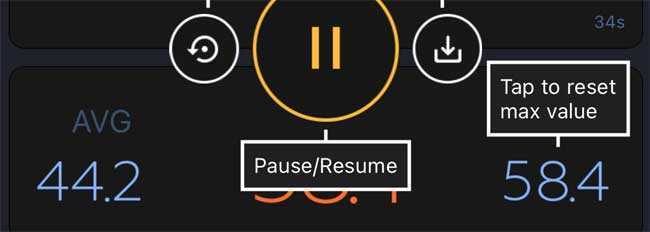
499 in the office.
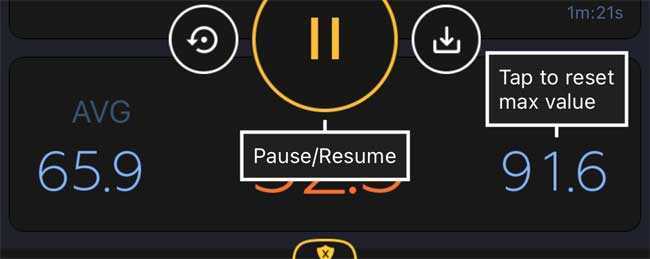
The Diana 35 shot in the office.
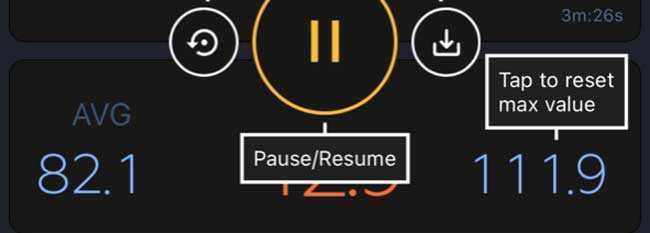
The .22 RAW shot in the office.
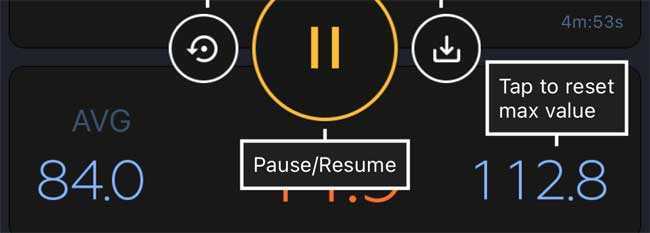
.22 LR unsilenced in the office.
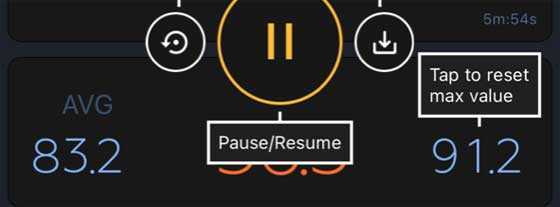
.22 LR silenced in the office.
Interesting
Well, that was interesting. The silenced .22 long rifle cartridge is a bit quieter than the Diana 35 breakbarrel rifle. And the RAW .22 is right up there with the unsilenced .22 rimfire.
Now let’s see what these same shots do in the garage. Again I will give you the numbers and then show the meter shots.
Test in the garage
In the garage I set the smart phone sound meter up where I regularly record discharge sounds. And what I got was astounding!
Once again, the number on the left indicates the average sound level in the place where I am testing. In the garage this number stays relatively constant, but a truck driving by will move it higher.
Daisy 499 — 109.0 dB
Daisy 499 — 110.1 dB I retested because I didn’t believe the first test.
Diana 35 — 108.0 dB
RAW HM-1000X — 104.4 dB
.22 LR unsilenced — 113.2 dB
.22 LR silenced — 111.4 dB
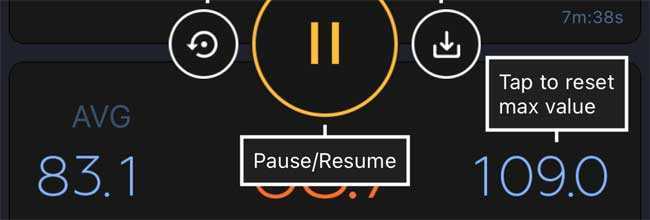
The first shot of the 499 in the garage. I didn’t believe it, so I shot again.
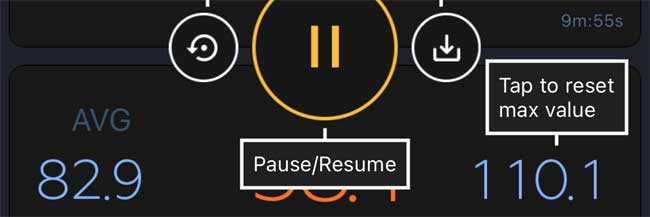
Okay, something is happening that I can’t explain.
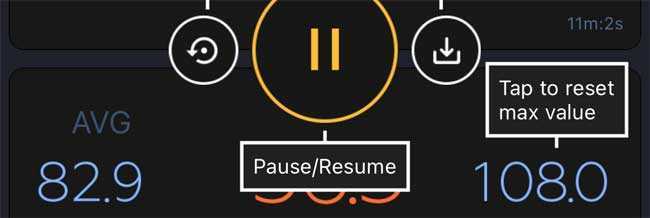
The Diana 35 in the garage.

The RAW in the garage.
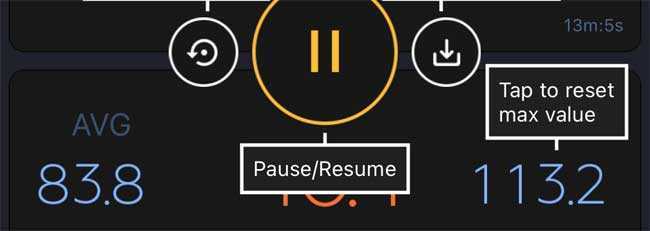
The unsilenced .22 LR was the loudest in the garage, but only by a small amount.
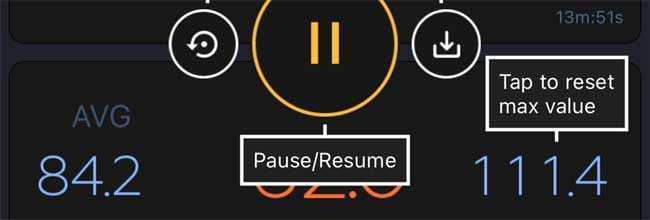
The silenced .22 LR wasn’t that much quieter.
Wow!
Well, it’s pretty clear that testing sound in the garage is a no-go. Even the Daisy 499 was loud out there! I tested it a second time, just to be certain that the first number wasn’t a mistake. Obviously it was a mistake, but it wasn’t one I was going to correct in my garage.
Look at the RAW figure. Not only is it lower out there than it was in my office, it’s quieter than both the 499 and the Diana 35. You know that can’t be true. I’m sure that harmonics are at work here (like the steel BB hitting the back of the steel bullet trap) but beyond that, I don’t want to say anything because I simply don’t know.
I do know one thing, though. I now know why sound testing in an anechoic (non sound-reflective) chamber is so important. You get nothing when a Radio Shack sound meter is used and someone has to guess how high the needle spikes.
Discussion
I am as surprised as you by these results. But it seems like the numbers I get when I test in my office are closer to reality than when I test in the garage. I wouldn’t call those numbers correct, but they are probably close approximations. And the relationship between the reports of loud airguns like the RAW and quiet ones like the 499 is maintained pretty well in my office tests.
In the office I shoot into duct seal that makes very little noise. In the garage I shoot into a metal bullet trap. Big difference.
Summary
Well, I started this test with one expectation — that sounds in the garage would be louder than sounds in my office. They were — but not at all how I expected.
If anyone had tried to convince me that a Daisy 499 BB gun would be louder than a high-powered .22-caliber RAW, I would have said it’s impossible. And it is, but my garage is the wrong place in which to test sounds. That’s very clear.
So, from this point on I will test all discharge sounds either in my office or somewhere other than my garage. We will all know that the numbers I give are somewhere in the ballpark, but are not to be taken as fact. I don’t have the laboratory for that.
I hope what I’ve done here today demonstrates the difficulty of accurately assessing impulse sounds, such as the discharge of a gun.
Oh, fudge!
My neighbor, Denny, who goes by the handle Sawdust when he comments here, said I now have to test the same shots in the garage while I’m shooting into the duct seal trap. It makes sense, which turns this test into a Part 1.


B.B.,
I can imagine a Part 3 where you recreate your box silencer (described in /blog/2006/2/airguns-and-noise/ ) to show it’s effectiveness. I think the Duct Seal as a target will make a big difference in noise reduction.
Siraniko
“I can imagine a Part 3…”
Siraniko, you’re really keeping B.B. on his toes! LOL =>
B.B.,
There were definitely some surprises here; in the office, this one:
“And the RAW .22 is right up there with the unsilenced .22 rimfire.”
And in the garage, this one:
“Daisy 499 — 110.1 dB I retested because I didn’t believe the first test.”
Yes, this report was a real shocker, but thanks for the info…good to know.
I’m looking forward to the follow-on report. =>
Take care & God bless,
dave
BB,
Very likely your change of targets will affect readings. This is why I suppose that all the airgun testers who use sound meters disclaim the readings of their meters.
I have to agree with Danny. To make a valid comparison, you need to control as many variables as possible.
Roamin Greco,
Well, I will try it that way.
BB
BB
Believe you have said that a neighborhood friendly airgun is one whose discharge is acceptable to someone outside in their yard next door. Ask Dennis to have your decibel monitor on his property and record a couple of shots. Dennis can record his own subjective loudness opinion. This should either validate or dismiss your sound test setup.
I’m no acoustical engineer but wondering if sound measurements from the airgun are cancelled out or altered by either echo and the steel trap.
Deck
Deck,
Interesting.
BB
B.B.,
As a point of reference a conversation between two people in a medium sized living room ranges from 55 dB to 65 dB. (I base this on observing SPL meters in various guitar oriented youtube channels.)
Also, cell phone microphones have tiny elements and the phone perhaps has compression and frequency-limiting software built-in. Therefore, I strongly believe you should compare your phone app SPL meter with two or more handheld units to see how much variance there is among them. I think you will find a surprising amount of variation, but I am also curious to know if your app produces a far different result than the others.
Michael
Michael,
Well, unless someone gives me a meter, that ain’t-a-gonna happen!
BB
B.B.,
I just now conducted my own experiment with my handheld, needle-metered Radio Shack SPL meter.
My 499 registered an average (of four shots, in my living room) of 84 dB. In the same room my voice at conversation level was 64 dB. These results have me suspecting your cell app-based meter is measuring low. That does not matter at all if you compare tests with it to other tests done with it under identical conditions. I am confident the app is consistent with itself, so for purposes of comparison it should be quite effective.
The unusual results you had with what should have been quite loud reports in the garage has me thinking compression software in the phone is reducing explosive, dynamic transients.
Michael
Michael,
Thank you for doing that.
BB
… if tree falls in the forest and there is nobody around to hear it does it really make a sound? 🙂
Interesting, very interesting stuff!
Excellent timing on this report BB! I’m tuning my Impact to shoot slugs and just installed this app as a means to help calibrate the valve timing.
As to your results (which raise more questions than answers LOL!) I have a couple of (wild) guesses.
I’m expecting that the microphones in cellphones are actually good as far as sensitivity and response goes. Presuming they are, there could be a difference between the way a direct sound (like a single sound – a spoken word) and multiple, layered reflected sounds (like from a single sound bounced off of many surfaces – floor, walls, ceiling, etc) arriving at the microphone at slightly different times are “heard” by the microphone and processed by the app.
Think that sound testing needs to be done away from “reflecting” surfaces to get a true reading. So that means testing outdoors (like in a pasture a good distance from buildings and roads) or using an anechoic chamber.
I’ve made anechoic chambers out of corrugated cardboard boxes. They quick/easy/cheap to make and worked very well. A visit to the local appliance store for the cardboard; access to a tablesaw and a cartridge of construction adhesive are all that is needed.
For my application (tuning) more I’m interested in the delta between shots more than the actual value – though that would be a good baseline to have for reference.
Being that we are doing amplitude sound level testing, I’m thinking that the ambient background sounds level are not relevant to the test as long as they are well below the peak level being tested.
Hoping you do a couple more blogs for this series BB.
Hank
Hank,
That’s what I’m thinking, as well. The human ear may not pick up on the reflected noise, but the sensitive mike in a cellphopne does.
BB
Hank,
I always like to hear or read a classic koan. Here is another that applies: What is the sound of one hand clapping? :^)
michael
Michael
Depends on what you are clapping that “one hand” up against. 😉
Michael,
How ’bout this one. If a man speaks in the woods and his wife is not there to hear, is he still wrong?
Half
Halfstep
Without a doubt, my favorite.
Ed
BB,
Good test and a great read!
The bottom line is that a garage is one of the worst places to test the noise level of anything for exactly the reason you stated – the reflections off hard surfaces. The office is much better, but still not the best.
There are three things you mentioned throughout the report that all work together, and many others as well that have a factor in this this: hard surfaces, reflections, and impulse sounds.
First, the reason engineers test sounds in anechoic chambers is because we want to test the sound of the one thing we are testing – if we test in a regular room, we are testing two things (actually three things): the sound the object makes, the sound signature of the place we are testing, and the results we get with the meter we are using (all have different characteristics).
When a device makes a sound, there is typically a whole array of sounds involved – multiple frequencies over a period of time. Picture testing a vacuum cleaner as you turn it on and then off – the click of the switch, then the whir of the motor, the air flow, then it shutting down. Some are steady state, some are impulses. All flow together. With our guns, the sounds are dominated by more of a peak impulse kind of sound, but even there we have multiple impulses involved. There is the peak impulse of the action, the muzzle discharge, and the the projectile impact on the trap. All three occur as different times and with different frequency characteristics too.
So if we shoot that gun in the anechoic chamber, we are going to get those three peak impulses with no reflections, and one of them will be the “loudest” – the higher sound pressure level, per some weighting scale. Of course, with the right equipment, we could measure the full spectrum array of sounds emitted by that gun, with frequencies and amplitude over time, but the meter we use for most of these test (me too) are only instant read across all frequencies and amplitudes at the point in time, with the ability to capture the peak that was read by the meter and hold it for us.
But in any kind of a “normal” room, we also have reflections of sound hitting the sound meter that are swept up into that same instant read value. Depending on the space, it is very possible for the reflected sounds to be added together in a way that the peak sound pressure point might not actually be from the initial sound that was generated, but from the reflections adding together either to another sound impulse, or may even just to the reflections adding together as well.
Add in the fact that the reflections are not all simple and things get complicated very fast – for example, in the garage you have a reflection path from the muzzle to the meter that will be very loud coming from the floor, from the steel door, and also from the floor to the steel door and to the meter all three arriving at different times. And of course there are countless other combinations, some of which will coincide with each other. So in all likelihood, the peak sound that is recorded (and also heard by our ears) in the garage is not the muzzle report (the likely loudest sound of most of the guns, if not the 499), but something later in the sequence like the pellet impacting the trap combined with reflected sound waves (or just reflections of all three if the sequence works out that way – remember the time from the muzzle sound to the impact is different for all guns as the projectile velocities are different).
By the way, all this is true for the shots tested in the office, but the sound environment is different (different levels of reflections and time for them to travel to the meter).
If you switch to the duct seal trap in the garage, you will get different results – most likely lower, as you are lowering the total acoustic energy in the space. But you likely won’t be getting down to the level of the tests in the office.
Probably the best place to test for peak sound levels is actually outside, as the sound waves dissipate better – although you do have to consider the house and your fence as well.
Here is an interesting real world example using steady state sounds having the same kind of result, and I am sure most of you have seen a similar example yourself: I live in an area that recently had power outages with people running generators, and while walking I noticed several times that a generator would suddenly sound like it had “moved” – I could see and hear the generator, but while walking I had moved to a position where the sound of that generator was bounding off a brick wall of a nearby house in such a way that I was hearing a louder combined sound reflecting off the wall than I was hearing by line of sight from the generator itself. I could see the generator, and knew it was running where it was, but suddenly it sounded like it was in front of that wall. Very clearly, the reflection was louder than the source. The “soundscape” was having a bigger effect than the source itself . . . this was longer than I had planned, but such are the results when I get to read these when I am on vacation! Have a great day!
Alan
Alan,
Wow! What a great answer! Thank you so much! 🙂
BB
BB-
A very interesting blog today. Certainly, this raging river topic is both deep and wide. I have confidence that you will steer (us) safely through the shoals and boulders.
I would suggest the following could be interesting- two phones with the same app installed. Four measurement phases-
Both phones (A and B) near the gun at time of firing
Both with neighbor Dennis
Phone A beside gun, phone B with Dennis
Switch phone locations
Four shots, eight measurements. Could reveal disparity between phones and apps and also, with Dennis’s subjective opinion, help guide the discussion of ‘backyard friendliness’.
Paco,
Sounds great, unfortunately ther app rents for $4.50 a month. I doubt I can talk Denniy into purchasing it.
How about it, Sawdust? 😉
BB
This is a very important topic for airgunners. Most airgunners are very interested in their guns being as quiet as possible whether they shoot indoors and/or outdoors. The number of Urban airgunners is growing and their concern about being respectful of neighbors is apparent everyday on many airgun forums. Look at the number of company’s that manufacture silencers for airguns if you have any doubt about this.
Greatly appreciate B.B. taking a deeper dive into this subject.
I don’t know anything about sound meters. I do a lot of work with church organizations. A very common “upgrade” across all denominations is to improve sound quality in the Sanctuary/worship center. We usually call on AcousTech for this type of work. I’ve witnessed them setting up and taking sound measurements with their sophisticated equipment in order to advise what modifications can be made to the space to improve sound quality.
Earlier I spoke to Jason at AcousTech to learn what equipment he used. They rely primarily on their Bruel & Kjaer 2270 sound meters. I did a search for these meters and found several interesting things:
1-A company that manufacturers silencers for guns uses this same sound meter for testing their silencers since, “The MIL-STD-1474D is the standard military test to measure potential hearing damage from noise. This is the industry-accepted standard for testing silencers, too.” This article also explains how and where they set up the sound meter:
https://www.silencershop.com/blog/post/test-silencers
2-Jason said that he didn’t know the current cost of a Bruel & Kjaer 2270 but guessed it would be around $10,000. You have to request quotes to know what the price of a new one would cost but I found a place that sells them used:
https://monkeedeals.com/home/product/bruel-kjaer-2270-octave-band-sound-level-meter-zc032-preamp-4189-mic/
BB
Interesting test.
And I agree with Denny’s idea.
And also agree a outside test should be done. But in some kind of open area away from even your truck. Just you and the gun out in the open.
Or to think more about this. We should actually be doing the sound tests from where we do our actual shooting from all the time. That is what we always hear anyway when we are shooting.
I shoot from inside the breezeway for the majority of my shooting with the muzzle of the barrel outside. And what is strange is my gun always seem quieter when I’m standing out in the yard about 20 yards from the house. And keep in mind its all open area with the minimum of 100 yards is the closest tree lines away on the sides of me with straight out in front of me alot more farther times 4 or more. So maybe that’s why it seems quieter to me when I shoot outside than in the breezeway.
Oh and if I have the gun fully inside the breezeway and shoot out the window into the yard the gun is real loud compared to standing outside in the yard shooting.
There are too many variables involved. I believe the only sound reading producing accurate consistent results would have to be taken outside in a relatively quiet area. Steve Scialli (Airgun Nation) always measures sound readings outside with his meters at various distances from the muzzle. I do not have a sound meter but my ears, and my wife’s, tell me that the lowest sound from my airguns is outside. My basement is not partitioned off and when I shoot in my basement range the sound from my Gamo Urban is less than my Diana 34. My wife tells me that the sound upstairs is louder with the Diana also. She actually complains if I shoot my Diana 34 downstairs, but not so much when shooting the Urban.
Now shooting in the garage is another story. I do some pesting in the front yard from inside my garage. The ceiling and walls in my garage are plastered. I rest my rifle on top of my SUV to dispatch sparrows and starlings from my bird feeders. The Urban is much louder in the garage and the sound is similar to a nail gun. When I pest from my wife’s sewing room with the barrel poked outside the window, the sound is minimal and the squirrels are not even scared off…I do not shoot the squirrels. So from my perspective, the sound in the garage is loud compared to the sound in the basement or outside, which is much quieter. Loudness of an airgun is subjective.
GF1,
I used to hunt snowshoe rabbits in the cedar swamps at the cottage. Between the foot-deep moss on the ground and the cedar trees the sound from a .22 rimfire was totally attenuated after 20 yards and a 12 ga was just a dull pop.
Erie walking around in those swamps.
Hank
Hank
Yep the snow usually makes it quieter when I shoot. And right now the corn is about 6 foot tall out in the field. It seems to quiet the sound also.
b.B.
I do not see a reference to what moderator you were using? Did you use the same moderator on the PB .22 as the air rifles? When testing airgun moderators I get different results with different moderators. I have 6! lol.
-Y
Yogim
I’m not using an airgun “moderator.” I’m using a legal Pilot silencer for a .22 firearm. And I only use it on the firearm.;
BB
So what do you use on the airguns?
-Y
PS you might like this?
https://www.cnet.com/roadshow/news/2021-harley-davidson-sportster-s-first-ride/
Yogi,
I shot each gun as it came from the factory. Only the RAW has a moderator.
Sorry, I misunderstood.
I thought that you shot each gun silenced and unsilenced both in your office and garage. Why don’t you silence the D350? get a slip on adapter and a screw on LDC?
-Y
In two-way conversations with both ends using an iPhone, I have noticed that certain ambient sounds from the other side are amplified. For instance, someone crinkling a plastic bag of potato chips sounds like an atomic car crusher from the other side. I don’t think that an iPhone can be considered accurate in any way for SPL measurement. Back in my early engineering days, I did noise surveys using calibrated B&K instruments, and I recall them being incredibly expensive. The process requires a lot of careful setup to get accurate readings – those microphones were very directional. All that said, I do think that there are inexpensive instruments that would work much better than a smartphone. Might be worth getting one, not all that much money.
See https://www.amazon.com/s?k=spl+measurement&ref=nb_sb_noss
When I pick up the phone, I only have a land line, from somebody calling from a cell phone, often I can not recognize the person’s voice. When they call from a land line, I have no problem identify who they are.
-Y
Having read all the comments posted so far, my 2 cents is that the best we can expect given B.B.’s available resources is a *relative* reading–in other words, some objective way of measuring that one gun’s report is louder than another’s. I think it may be valuable to measure a few things: 1) at or near the muzzle, 2) at or near the shooter’s ear, and if the neighbor is willing, 3) the sound at the distance of the fence, and 4) the sound on the other side of the fence. I don’t know if B.B.’s neighborhood circumstances would permit this sort of test out of doors in his back yard, but that seems to me to be the best place. I think all the tests need to be done in the same place. And to minimize the noise of the pellets and bullets clanging around in the pellet trap, the duct seal trap should be used for all tests. Additionally, for reference, readings should be taken of some other sounds like clapping, etc. In my view, as long as the test shows the same guns are relatively quieter or louder than the others in all the tests, we can conclude that B.B.’s cell phone sound meter is providing relatively usefu comparative data. As long as we understand that it may not be a precision sound measuring instrument, ot that the measured decibels are accurate. I think we’ll find that he will record relatively reliable comparisons, as long as the other variables are controlled.
Roamin,
No, my neighborhood would not take well to that test. The quiet guns may be okay, but the RAW and the unsilenced .22 rimfore definitely not.
BB
B.B. is it really sound pressure levels? Or is it that your neighbors, loved ones and family members have the dreaded Neurological Disorder MISOPHONIA!
I have lived aboard Naval Air Stations or near them most of my life and have heard the phrase: ‘Ah! The Sound of Freedom often.’ I have lived near the flight paths of Ronald Reagan National airport and have heard neighbors exclaim, ‘G___D___ airplanes!’
I’m certain none of you ever complains about the pop (as long as the level is safe or you are wearing appropriate sound attenuation gear) sound of airguns going off.
I have written about my ‘burbs neighbors and talking to them (especially the new ones) about my shooting in the back yard. I show them 10 meter targets mounted on backer boards and explain the trap system to help them understand SAFE PRECISION shooting, tell them the rifles and pistols will never be louder than a gas lawnmower, leafblower, nailgun, or the guys HD or new Mustang down the street. Then I tell them about the Range Hot flag and never coming into the backyard without calling my mobile if the RED flag is displayed. I also invite them to come over and try their hand on an Olympic 10 Meter airrifle if they want.
So far i have never had a neighbor who suffered Misophonia from my shooting activities. Hm…some of them verge on it about the Mustang and the Hog!
But then those two are never backyard friendly!
shootski
BB,
Are you using an iPhone? I ask because the CDC recommends a free app called “NIOSH (National Institute for Occupational Safety and Heath) Sound Level Meter” for employees to monitor the noise level in their work area. That app was only developed for the iPhone because Windows based and Android-based phones apparently don’t use the same audio software and hardware across all their models of phones and Apple does, making the app reliable on any iPhone. Here is a link to the article and within that is a link to download the app, if you care to. I found a number of articles that say most of the phone apps, regardless of price, don’t give reliable results, so that could be the problem here.
https://www.cdc.gov/niosh/topics/noise/app.html
Half